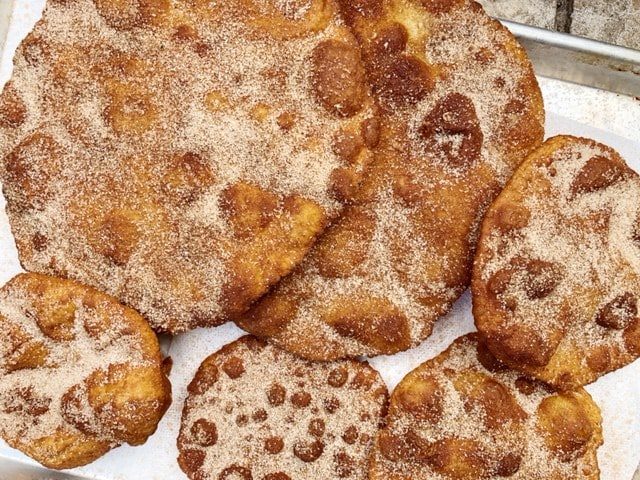Recipe: Indiana State Fair Elephant Ears

A stack of golden brown, crispy deliciousness dressed with sugar and cinnamon Courtesy Suzanne Krowiak
An informal social media poll of fair favorites had one clear winner: elephant ears. So named because of their resemblance to (ahem) an elephant’s ear, the large, mostly flat piece of fried dough is notable for its crispy exterior and chewy interior, with bubbles and wells that provide ample room for lots of cinnamon and sugar.
Like many foods that are popular in America, the elephant ear has an interesting and complicated history. Its origins are in the frybread of Native Americans, who created these big pieces of fried dough in the mid-19th century. Frybread was born of necessity, when the United States government forced Navajo Indians to move from their homes in Arizona and relocate to New Mexico during the “Long Walk” of 1854. The new land didn’t support the traditional Navajo diet that was heavy on vegetables and beans, so the government provided commodity boxes that consisted mostly of things like flour, lard, sugar, and canned goods. Frybread was invented with the ingredients from the box. It can be made sweet or savory, and is still popular at Native American powwows and cultural events, a symbol of the creativity and survival skills of indigenous people.
It’s hard to pinpoint a date when elephant ears became a staple at state fairs, but there’s no question they’re one of the biggest draws now. Google “top ten fair foods” and almost every list will have elephant ears at or near the very top. Newfangled Confections founder and owner Carrie Abbott’s birthday memories are inextricably linked to the foods of the Indiana State Fair. “I have an August birthday, and I thought the fair was one long extravaganza of food and farm life just for me,” says Abbott. “The one memory that has become a tradition is enjoying the cinnamon-sugary fresh-fried elephant ear pastry from the Red Barn in front of the Family Arts building, just outside the midway entrance. For as long as I’ve been attending, that’s been my place.”
Abbott shared her elephant ear recipe for home cooks, and this is a fairly easy project that can be done at home on a lazy afternoon. One thing that will make it super easy and quick: a stand mixer with a dough hook. But if you don’t have one, never fear! You can knead the dough by hand on your kitchen counter. Another useful tool is a kitchen thermometer, which can be picked up inexpensively at most grocery or big box stores.
Read through the entire recipe before you get started, including the notes at the end. And we’d love to see your elephant ear handiwork. Post your pictures on social media and tag us at @IndyMonthly or use hashtag #INStateFairAtHome.
The most important thing here is to have fun. Don’t stress about achieving the perfect shape or color. Fried dough with cinnamon and sugar will taste good no matter what it looks like. We’ve all got enough to worry about at the moment. For your own mental health, cross perfection off the list.
Happy frying!
ELEPHANT EARS

Ingredients:
Dough
- 1 ½ cups milk
- 1 tsp salt
- 2 Tbsp sugar
- 3 Tbsp shortening
- 2 Tbsp active dry yeast (3 small packages is enough)
- 4 cups all-purpose flour
- 1 quart vegetable or canola oil for frying
Cinnamon Sugar Topping
- 1/4 cup cinnamon
- 2 cups sugar
- Pinch salt
Yields: 4 state fair-sized elephant ears, or 8 treat-sized elephant ears
Instructions:
- Cook milk, salt, two tablespoons of sugar, and shortening in a saucepan over medium heat. Cook until shortening melts and sugar dissolves. Remove from heat and let cool to lukewarm temperature, approximately 110 degrees. (Transfer to a bowl and whisk lightly if you’d like to speed up the cooling process.).
- Sprinkle yeast on top of the lukewarm mixture and gently whisk the top layer. Let the mixture sit undisturbed until foamy, approximately 10 minutes.
- Transfer to a mixing bowl, add flour and stir. Knead with the dough hook in a stand mixture until smooth, approximately 10 minutes. (If you don’t have a stand mixture, knead flour by hand on your kitchen counter until smooth.) Cover the dough in a bowl and let rise for about 30 minutes.
- Combine the cinnamon, sugar, and pinch of salt in a bowl and set aside.
- After the dough rises, divide it into four or eight sections, depending on the desired size of elephant ears. Roll each section into a ball.
- In a large heavy skillet or deep fryer, heat one inch of oil to 375 degrees.
- Roll one dough ball into a thin sheet on a lightly floured surface.
- Carefully lower the dough sheet into the hot oil and fry on each side until puffed and golden. (This will happen fast. Anywhere from 30 seconds to two minutes per side. You can flip it frequently with tongs to be sure you don’t burn it.)
- Drain on paper towels and sprinkle liberally with cinnamon-sugar mixture while warm on both sides.
- Enjoy immediately.
Notes:
- Frying: 375 degrees should be monitored by a thermometer, but if not handy, drop in a small piece and test to see if the oil is too hot or cold. (If the oil doesn’t react at all to the dough, it’s too cold. If it splatters or burns the test dough very fast, it’s too hot.)
- If making regulation-sized elephant ears, you may have to use tongs to push down in the middle so that a dome isn’t formed and that the middle can be fried.
- Almost as soon as you drop the dough in the oil, it will be sturdy enough to move it around. Don’t be afraid to flip it frequently to check how brown it’s getting. Tongs are the easiest way to do this.





